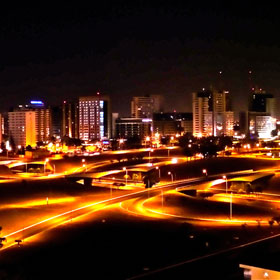Brasilia: Welcome To Amazing The Future
In Terry Gilliam’s dystopian black comedy Brazil, Jonathan Pryce plays a lonely clerk longing to escape a cold Brave New World overrun by inefficient and terrifying bureaucrats. As he hears and hums Ary Barroso’s 1939 “Aquarela do Brasil,” he dreams of flying away to a more sensuous coastal city that embodies the spirit of samba.
You might hear echoes of Pryce’s pining in the real Brazilian capital city of Brasilia, one of the most divisive and curious cities in the world.
For a country known for its spectacular beaches, rainforests, and waterfalls, Brazil’s capital is a surprising anomaly. Located in the central-west Brazilian Highlands, Brasilia is a sprawling, futuristic city filled with imposing black glass and smooth, white, curving concrete. When President Juscelino Kubitschek decided to move the capital from Rio in 1956, he hired urban planner Lucio Costa and visionary architect Oscar Niemeyer to build Brasilia in the uninhabited interior region in 1,000 days. The result is a Jetsons-like futuristic city rising out of the South American savanna with some of the most striking modernist architecture in the world.
As the country prepares for a major tourism boom due to the World Cup this summer, many travelers — particularly those with a passion for architecture and design — should consider putting this cidade futura on their itineraries.
While its critics see a failed utopian experiment that further separates the haves and have-nots, its admirers point to the inspiring genius of Niemeyer, who designed over 25 of the city’s major buildings. As an ardent communist until his death at the age of 104 (just over a year ago), Niemeyer believed that his bold structures could provide hope for a struggling population; “It is strange how the power of beauty makes us forget so much injustice,” Niemeyer once said in a piece for Módulo Magazine.
Inspired by the curves of Rio’s Sugar Loaf Mountain — along with the tanned women sunbathing on the shore of Copacabana Beach — Niemeyer’s designs consistently reject hard right angles in favor of more sensuous contours. According to Niemeyer, form doesn’t follow function; “it follows female beauty.”
Quite simply, this is a city that can’t even think straight; no, really, there’s not a single right angle on Costa’s curvy plan. The layout of the city resembles an airplane with a “monumental axis” (featuring most of the key buildings and attractions) running vertically down the center, flanked by two residential “wings.” Its design requires that you have a car or taxi for transportation; you won’t find many pedestrians strolling around.
Bear in mind that many of the streets have no names, and Brasilia’s sector-oriented complicated address system may baffle you at first. Costa’s layout of the city divides its neighborhoods based on the functions of their buildings. For example, most of the hotels are located in the hotel sector, which is separate from the residential and commercial sectors. While there is a thriving nightlife scene in the club sector, you’ll also occasionally find pop-up parties or clubs in the “garage” or banking sectors.
You’ll really need two days to fully explore all of Niemeyer’s masterpieces; or, you can cram some of the cultural highlights into one busy day.
Start your morning at the Digital TV Tower, also known as the Cerrado Flower, which is Niemeyer’s last building erected in the city (in 2012). The observation deck on top features a 360-degree panorama of the city, with an uninterrupted view of the horizon (as mandated by Costa’s plan).Palácio do Planalto, housing the Office of the President, in Three Powers Square
Then visit the Three Powers Square, a plaza where the three branches of Brazil’s Federal government meet (the National Congress, the Supreme Court, and the Presidential Office).
 Niemeyer was an outspoken atheist, and it’s no coincidence that his National Cathedral is far away from the seat of government, emphasizing the separation between church and state.
Niemeyer was an outspoken atheist, and it’s no coincidence that his National Cathedral is far away from the seat of government, emphasizing the separation between church and state.
The Metropolitan Cathedral of Our Lady of Aparecida is widely considered Niemeyer’s masterpiece. Its exterior resembles a crown of thorns; inside, angels hang from a spectacular stained-glass ceiling.
 The Dom Bosco Sanctuary (The Blue Church), built in honor of the Italian Saint who predicted a futuristic city would appear in Brasilia’s location, offers another breathtaking stained-glass interior, inspired by Niemeyer’s designs.
The Dom Bosco Sanctuary (The Blue Church), built in honor of the Italian Saint who predicted a futuristic city would appear in Brasilia’s location, offers another breathtaking stained-glass interior, inspired by Niemeyer’s designs.
At the Memorial for Juscelino Kubitschek, Niemeyer honors the Communist party by placing the former president on top of a sickle. Inside, a granite tomb underneath a skylight holds his remains.
 For more of Niemeyer’s spectacular interior design, visit Itamaraty’s Palace, headquarters for the Ministry of Foreign Affairs, which features impressive works by leading Brazilian sculptors Maria Martins and Franz Weissmann.
For more of Niemeyer’s spectacular interior design, visit Itamaraty’s Palace, headquarters for the Ministry of Foreign Affairs, which features impressive works by leading Brazilian sculptors Maria Martins and Franz Weissmann.
At sunset, spend some time at the Ermida Dom Bosco, where Brasilia’s first small chapel sits, overlooking a park and a view of Paranoa Lake.
Then head over to Pontão do Lago Sul, the city’s largest lakeside leisure and entertainment complex, where you’ll find several bars, shops, and restaurants for Happy Hour.
For comfort cuisine with a young, hip crowd and spirited atmosphere, book a table at Universal Diner, owned by chef Mara Alcamim (who worked for many years in New York). Alcamim’s delectable “Sexy Shrimp” (cooked in brie, champagne, red roe, and exotic strawberries served on sage risotto) is said to have aphrodisiac qualities. Though it might accentuate the curve of your waistline, Niemeyer would certainly approve.
Get the most-revealing celebrity conversations with the uInterview podcast!






Leave a comment